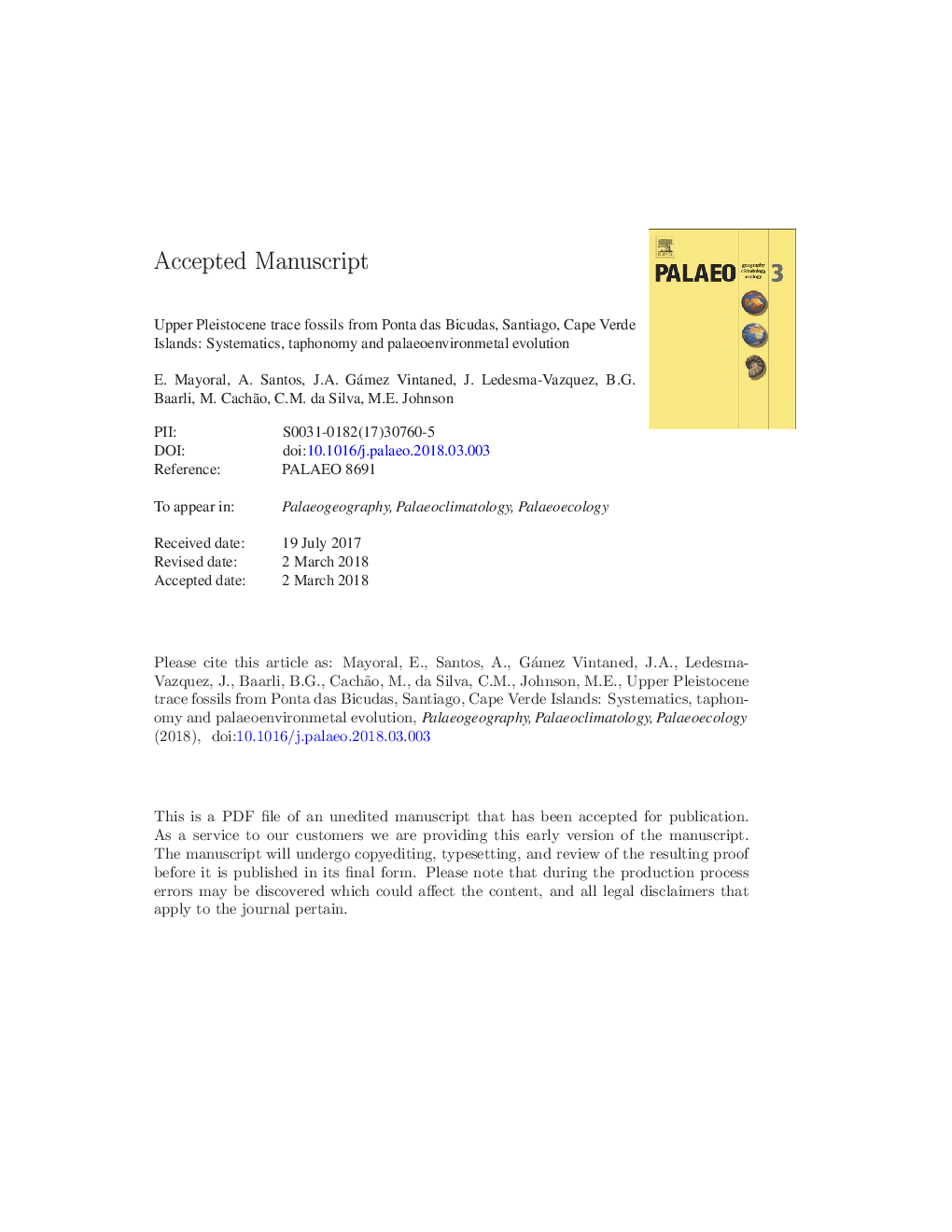| کد مقاله | کد نشریه | سال انتشار | مقاله انگلیسی | نسخه تمام متن |
|---|---|---|---|---|
| 8868243 | 1622094 | 2018 | 57 صفحه PDF | دانلود رایگان |
عنوان انگلیسی مقاله ISI
Upper Pleistocene trace fossils from Ponta das Bicudas, Santiago, Cape Verde Islands: Systematics, taphonomy and palaeoenvironmetal evolution
ترجمه فارسی عنوان
فسیلهای رشته پیلوستوکن بالا از پونتا داس بیکوداس، سانتیاگو، جزایر کیپ ورد: سیستماتیک، تکامل و تکامل محیط زیست
دانلود مقاله + سفارش ترجمه
دانلود مقاله ISI انگلیسی
رایگان برای ایرانیان
موضوعات مرتبط
مهندسی و علوم پایه
علوم زمین و سیارات
فرآیندهای سطح زمین
چکیده انگلیسی
Bioturbation structures from Ponta das Bicudas in Santiago Island, Cape Verde Archipelagoare located in coarse-grained biocalcirudite sandwiched between basaltic lavas of the Upper Pleistocene Assomada Formation. Four ichnospecies have been identified: Rhizocorallium commune irregulare, Rhizocorallium jenense versum, nov ichnosubsp., Alaichnus kabuverdiensis nov. ichnogen. nov. ichnosp. and cf. Dactyloidites. From a taphonomic point of view, most trace fossil specimens are undergoing throughout intense erosion. Nevertheless, the observations made on their taphonomy and state of preservation allowed i) to reconstruct the original, complete structures of the trace fossils, ii) to evaluate the existence and magnitude of erosional and depositional episodes, and iii) to quantify the reach of erosion on the seafloor sediment. In this context, it was possible to quantify the thickness of sediment being eroded at the final erosional episode, which happened right before the second extrusion episode of volcanic pillow lava, which buried all the traces previously formed: the total interval of sediment eroded was estimated in ca. 1â¯m. From a palaeoenvironmental point of view, in a synthesis, the traces were produced in a soft to stiffground substrate composed of very coarse-grained biocalcirudite with common rhodolith debris, in a shallow setting (4 to10â¯m of depth) with moderate wave energy, nearby rocky basalt knobs where corals and red coralline algae crusts were growing. Organisms producing Rhizocorallium commune irregular settled in the seafloor during a first phase of sedimentation, which was followed by an erosional episode. Once sedimentation resumed, specimens of R. jenense versum nov. ichnosubsp. were produced and overlapped with the former ones. Later, a new erosional event erased most of the previous traces, being preserved only the basal imprint of the specimens. This was followed by a rapid sedimentation episode where Alaichnus kabuverdiensis nov. ichnogen. nov. ichnosp. recorded intense bioturbation activity of the bivalve Panopea. Subsequently, under low-energy sedimentation, a new episode of intense bioturbation of the seafloor occurred, resulting in the development of abundant cf. Dactyloidites. Finally, a strong erosional event - probably related to the onset of the second volcanic episode - cut all previous structures before being buried by the overlying, well preserved pillow lava.
ناشر
Database: Elsevier - ScienceDirect (ساینس دایرکت)
Journal: Palaeogeography, Palaeoclimatology, Palaeoecology - Volume 498, 1 June 2018, Pages 83-98
Journal: Palaeogeography, Palaeoclimatology, Palaeoecology - Volume 498, 1 June 2018, Pages 83-98
نویسندگان
E. Mayoral, A. Santos, J.A. Gámez Vintaned, J. Ledesma-Vazquez, B.G. Baarli, M. Cachão, C.M. da Silva, M.E. Johnson,
